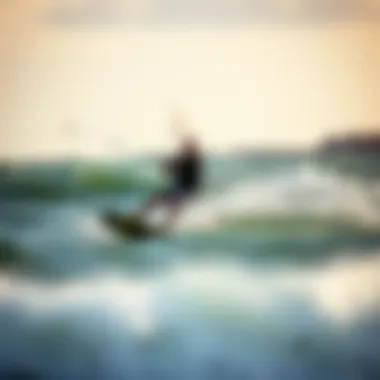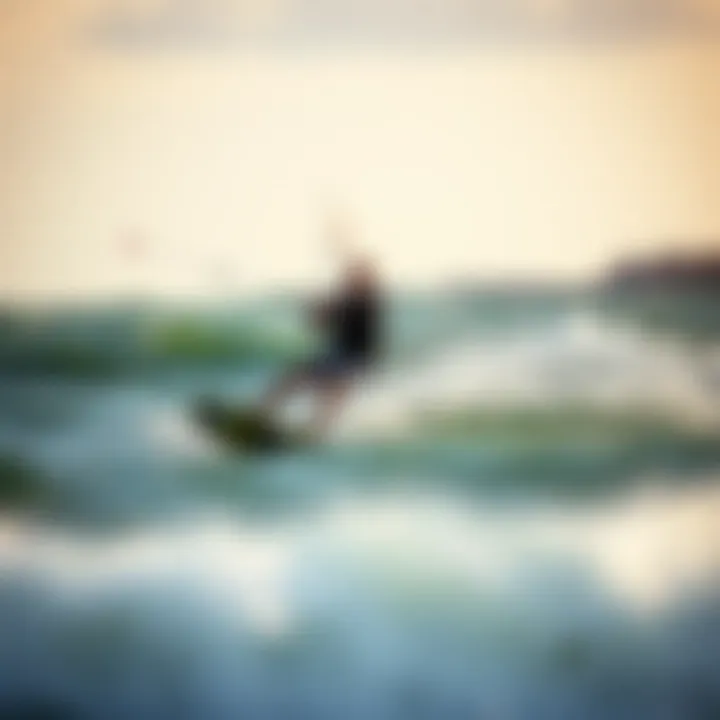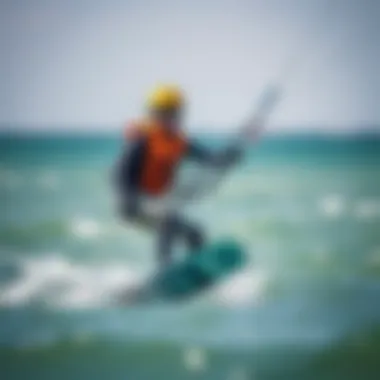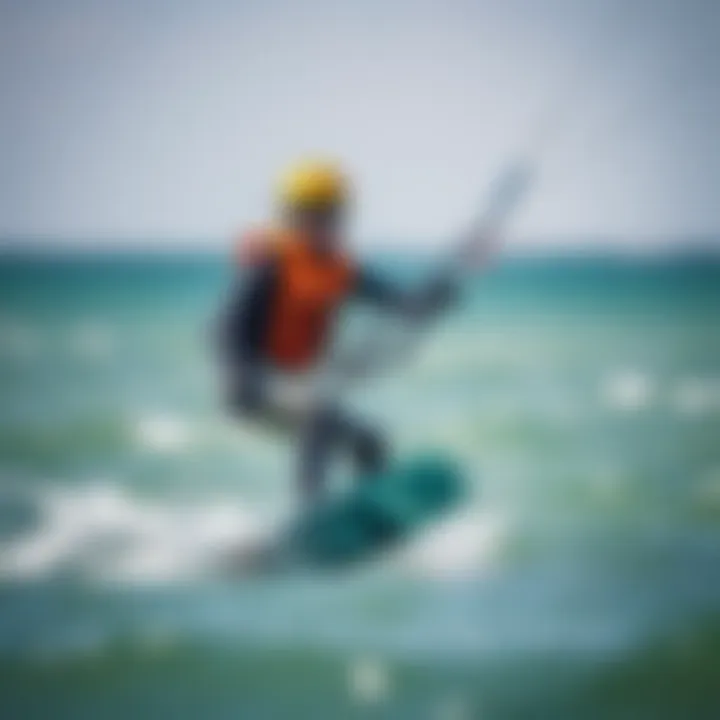Navigating Falmouth Tides for Kiteboarding Success


Intro
Kiteboarding in Falmouth offers not just thrilling rides but also a unique interaction with the ever-changing tides. The intricate dance between the moon's pull and the Earth's rotation shapes the conditions kiteboarders face each day. Understanding Falmouth's tidal patterns is crucial for anyone looking to master the art of riding the waves here. Navigating these waters not only enhances your skill set but protects you from potential hazards.
The tidal flows can vary greatly from one season to another, which means having a good grasp on when to hit the water is essential for optimal performance. Being in tune with the natural ebb and flow of the tides can also serve as a safety measure, ensuring that kiteboarders steer clear of dangerous spots or conditions.
This guide will take you through the basics of what makes Falmouth's tides so special, including how they affect your kiteboarding adventures. Coupled with insights on equipment, techniques, and safety tips, we aim to ensure you have a stellar experience every time you launch into the breeze.
With all this in mind, let’s dive into the sections ahead and equip you with the knowledge needed for successful kiteboarding in Falmouth.
Prelude to Falmouth Tides
Falmouth, a picturesque coastal town in Cornwall, England, is more than just a delight for the eyes. It is a dynamic interplay of land and sea, where tides rhythmically dance with the shoreline, unveiling opportunities and challenges, particularly for kiteboarders. Understanding the tides here isn't merely about knowing when to hit the water; it intertwines with safety, performance, and ultimately, the enjoyment of each session on the waves.
Although kiteboarding is often perceived as exhilarating escapades on wind-driven waters, the tides can drastically influence these thrilling adventures. The variations in water levels and flow can mean the difference between a smooth glide and a turbulent ride. Without an intimate understanding of Falmouth's unique tidal patterns, kiteboarders risk not only their performance but also their safety.
Geographical Context of Falmouth
Nestled at the mouth of the River Fal, Falmouth possesses a rather distinct geographical setting. This location allows it to experience varying tidal ranges, influenced by both the Atlantic Ocean and local river systems. The natural contours of the coastline further shape how tides ebb and flow, creating varied conditions at different times.
Falmouth’s environment extends beyond its shores. The presence of numerous islands and inlets amplifies the tidal effects, often creating microclimates that can be either friend or foe to kiteboarders. Understanding where these geographical features lie in relation to tidal forces can greatly improve a kiteboarder's strategy.
Importance of Tidal Knowledge for Kiteboarders
For kiteboarders, grasping the dynamics of tidal movements isn't just an academic exercise; it’s a prerequisite for a satisfying experience. Knowing when the tides turn can help kiteboarders time their outings effectively, optimizing conditions for wind and wave action.
- Tidal Currents: Understanding the nature of tidal currents aids in harnessing the wind effectively. Kiteboarders can ride with the current, turning potential challenges into thrilling advantages.
- Safety First: Knowledge of high and low tides plays a crucial role in ensuring kiteboarders aren’t caught off-guard. Some areas may be charming at a certain tide level, but perilous when the tide shifts.
- Play the Patterns: Tides create different wave formations; some may favor jumps while others make for smoother glides. Familiarity with Falmouth’s tidal variations allows for better session planning and skill development.
By aligning their kiteboarding adventures with tidal schedules, enthusiasts can enhance both their safety and experience, making each outing more productive and enjoyable.
"Tides are not just a schedule; they are the heartbeat of the sea, dictating the rhythms of life on the water."
Overall, the significance of understanding Falmouth tides cannot be overstated. It's the backbone of kiteboarding here, influencing everything from the safety of practitioners to the overall quality of their rides.
The Science of Tides
Understanding the science behind tides is crucial for any kiteboarding enthusiast navigating the waters of Falmouth. Tides are not just random occurrences; they are governed by a complex interplay of gravitational forces and celestial mechanics. This scientific underpinning can make a world of difference in kiteboarding practices. Knowledge of these principles not only informs the best times for riding but also prepares kiteboarders for potential hazards that may arise due to tidal changes. By grasping these concepts, kiteboarders can maximize their performance while minimizing risks.
Gravitational Forces and Tidal Movement
At the heart of tidal activity lies gravity, primarily exerted by the moon and the sun. The gravitational pull from these celestial bodies causes the water in the oceans to bulge, generating high tides. Conversely, areas of lower water occur in locations perpendicular to these bulges, creating low tides. This cyclical dance leads to the regular rise and fall of water levels.
To elaborate further, consider how the alignment of the moon and sun plays into this phenomenon. During full moons and new moons, the sun, moon, and Earth align, resulting in higher high tides and lower low tides, known as spring tides. In contrast, during the first and third quarters of the moon, the sun and moon are at right angles relative to the Earth, leading to lower high tides and higher low tides—these are called neap tides. Understanding these forces helps kiteboarders anticipate when the best conditions might arise or when to steer clear of the water.
Spring and Neap Tides Explained
Spring tides and neap tides are essential concepts for kiteboarders looking to optimize their sessions in Falmouth.
Spring Tides:
- Occur about twice a month when the sun, moon, and Earth align.
- Result in significant differences between high and low tides.
- Can create stronger currents, which may enhance or hinder kiteboarding depending on your experience level.
Neap Tides:


- Also happen twice a month, during the quarter moons.
- Characterized by the least difference between high and low tides.
- Often provide calmer waters, ideal for beginners or those looking for a more leisurely ride.
Understanding the timing and effects of spring and neap tides can be the difference between an exhilarating kiteboarding experience and a treacherous one. To get the most out of this knowledge, enthusiasts are encouraged to consult tide charts regularly and remain aware of local conditions.
"A smooth sea never made a skilled sailor," they say. Knowing the tides prepares you for what lies ahead."
For further reading, resources such as Britannica and Wikipedia contain valuable information about tides and their mechanics, showcasing their importance in maritime activities.
Falmouth's Tidal Cycle
Understanding Falmouth's tidal cycle plays a crucial role for kiteboarders. This cycle determines the water levels, wave patterns, and overall conditions experienced on the water. By grasping the nuances of these tides, kiteboarders can better plan their sessions, ensuring optimal performance and safety.
Daily Tidal Patterns
The daily tidal patterns in Falmouth are influenced primarily by the gravitational pull of the moon and the sun. Typically, there are two high tides and two low tides each day, creating a rhythm that kiteboarders need to align with.
Navigating these patterns is akin to tuning into a natural clock. The time of high and low tides shifts slightly each day, approximately by about 50 minutes later than the previous day. This shift is essential to keep in mind, as it means that consistent timing is key. For those looking to ride on the rising tide, knowing the exact times can significantly enhance the experience.
The best conditions often occur near high tide, when the water is at its peak. Conversely, low tide can reveal treasures like sandbanks and obstacles that may not be visible otherwise. It's important to be cautious and aware of the changing landscape beneath the water. By using local tide charts, kiteboarders can easily track these daily occurrences.
"The sea is a fickle mistress; it demands respect and understanding." This quote perfectly encapsulates the need for kiteboarders to pay attention to daily tidal patterns.
Monthly and Seasonal Variances
The monthly and seasonal variances in Falmouth's tides further influence kiteboarding conditions. The gravitational forces that govern tides lead to variations that one should consider when planning a session.
Spring Tides occur when the Earth, moon, and sun align. These tides, happening about twice a month, yield the highest and lowest tidal ranges. It's during these times that the effect of the tides is most pronounced. Kiteboarders should be particularly mindful during spring tides, as the strong currents can create powerful and challenging conditions, which some may find exhilarating but may not be suitable for all.
Neap Tides, which happen between spring tides, are characterized by the least difference between high and low tides. This makes for a gentler experience on the water. For beginners or those looking for a less intense ride, neap tides can provide a welcome alternative.
Seasonal shifts can also impact water temperature and weather conditions, influencing how and when kiteboarders should hit the water. During the summer months, the tides may seem more forgiving, but increased foot traffic and variable weather can stir things up and affect safety. To ensure a safer experience, staying informed through local resources and tide prediction websites is advisable.
By blending knowledge of these monthly and seasonal shifts with the daily patterns, kiteboarders in Falmouth can harness a deeper understanding of the tidal influences at play. When properly utilized, this knowledge can undoubtedly lead to more rewarding kiteboarding sessions.
Impact of Tides on Kiteboarding
Kiteboarding in Falmouth isn’t just a leisure activity; it’s an intricate dance with nature’s rhythms. Understanding the impact of tides is critical for enhancing both performance and safety. To get it straight: the tide influences wind patterns, water depth, and even the behavior of currents, all of which play a pivotal role in the kiteboarding experience.
To fully appreciate these impacts, let’s break it down into two key elements: optimal conditions and associated risks.
Optimal Conditions for Kiteboarding
When the tide is right, kiteboarding in Falmouth begins to feel like pure magic. The optimal conditions usually align with the incoming tide, especially around high tide. This surge of water can create a sense of lift that enhances the thrill of riding.
- Good Wind Patterns: During a rising tide, wind patterns often stabilize, reducing gustiness. Kiteboarders will find that the water surface is generally smoother, allowing for easier control and better jumps.
- Depth Considerations: The depth of water increases with high tide, which is crucial for avoiding obstacles that can cause damage to both the kite and rider. Flat shallow areas become safer, offering the chance for trickier maneuvers.
- Enhanced Currents: Certain kiteboarding spots become more exhilarating as currents change with the tide. An incoming tide can create higher speeds, enabling advanced riders to push their limits.
For every kiteboarder looking to make the most of their session, it’s beneficial to keep an eye on local tide charts. Matching riding time with high tide often results in the most satisfying experience.
Risks Associated with Tidal Fluctuations
Riding the waves also means acknowledging that tides can carry unseen hazards. While high tide presents exciting opportunities, it’s not without its risks:
- Rip Currents: These currents can become more pronounced during full and new moons when tidal forces are especially strong. They can sweep even experienced kiteboarders away from the shore unexpectedly.
- Sudden Depth Changes: When the tide goes out, familiar riding areas may unveil obstacles like rocks, sandbars, or debris that were safely submerged. These abrupt shifts can lead to dangerous landings or equipment damage.
- Restricted Areas: Some spots may be safe during high tide but unsafe at low tide due to geographical changes. Staying informed about local advisories is essential.
Always remember: Assessing tides before heading out can not only protect one's equipment but also ensure personal safety.


Navigating Falmouth Tides
Navigating the tides of Falmouth is not just a matter of familiarity with the sea; it’s an essential aspect for any kiteboarder aiming to make the most of this dynamic environment. Kiteboarding, while exhilarating, carries its own set of challenges, especially when it comes to unpredictable tide patterns. Understanding how to effectively navigate these tides can make the difference between a smooth session and a challenging one.
The significance of this topic lies in the ability to harness the tides to optimize performance and enjoyment. For kiteboarders, knowing when to hit the water can mean the difference between ideal conditions and being caught in less favorable scenarios. Moreover, being attuned to tidal changes ensures that riders can avoid hazardous situations, such as strong currents, which can sweep them off course or lead to dangerous encounters.
Using Tide Charts Effectively
Tide charts are a kiteboarder’s best friend. They provide a clear picture of the expected tidal movements, showing high and low tides throughout the day. But, like any good tool, it’s only useful if you know how to wield it properly. When using tide charts, consider these key points:
- Understand the Timing: Tides are predictable, but their timing can change based on weather conditions, so always check charts close to your riding time.
- Look for Patterns: Each month has fluctuations. Understanding whether Falmouth is in a spring or neap tide can help you plan adequately. Spring tides often present optimal conditions for kiteboarding due to higher tidal ranges.
- Utilize Apps: There are many mobile applications that provide real-time updates and notifications on tidal changes, ensuring you remain informed even while on the go.
By diligently interpreting these charts, kiteboarders can align their sessions with the best possible tidal conditions, leading to enhanced performances and safer experiences.
"A wise kiteboarder never underestimates the power of tides; they shape your journey across the water."
Local Resources for Tide Information
For those looking to keep a pulse on the tides in Falmouth, there’s an abundance of local resources available. These can help kiteboarders stay informed, from real-time updates to more profound local insights. Key resources include:
- Falmouth Harbormaster's Office: Often, the Harbormaster provides useful tide tables that are specific to the area.
- Local Kiteboarding Schools: Many local instructors or schools offer classes that emphasize understanding tides, which is particularly beneficial for novices.
- Community Groups and Forums: Online platforms, such as Reddit, can be treasure troves for local knowledge. Kiteboarders share their experiences and tips on tides, helping one another navigate this ever-changing aspect of kiteboarding.
- Social Media: Following local kiteboarding groups or pages on platforms like Facebook can provide updates, tips, and even alerts about sudden tidal changes.
Harnessing these local resources can not only enhance your riding competence but also foster a sense of community, making every session a shared adventure. Remember, a kiteboarder well-informed about tides not only rides better but also rides safer!
Best Times for Kiteboarding in Falmouth
Kiteboarding in Falmouth hinges greatly on timing. Understanding the tide schedule is not just about personal preference; it ties directly to safety and performance. This section lays out crucial information that can assist kiteboarders in maximizing their sessions while minimizing risks.
Timing Your Sessions with the Tides
When it comes to kiteboarding, timing your sessions in accordance with tidal movements is key. The water conditions can vastly differ depending on whether you're riding during low or high tide.
- Low Tide Conditions: During low tide, you might encounter more exposed sandbanks and shallow waters, which can make for tricky conditions. However, some kiteboarders prefer this setting since it provides the opportunity to spin tricks without the risk of deep water.
- High Tide Conditions: Conversely, high tide offers deeper waters. This is typically favored for speed and distance runs. The waves usually build as opposed to shallow water at low tide, which can offer better jumping conditions as well.
To optimize your kiteboarding experience, monitoring local tide charts can be invaluable. You’ll want to arrive just before the tide starts rising or falling to catch the most favorable wind conditions. Breeze patterns often align with the tidal flow, allowing for smoother runs on the water. It’s as simple as checking the tide schedule and planning ahead.
"Always remember, the sea is a different beast at various tidal levels!"
Seasonal Recommendations
Venture out onto the water during specific seasons can make a world of difference in your kiteboarding experience. Falmouth has its own rhythm, and each season presents unique characteristics:
- Spring: As the days grow longer and the temperatures rise, spring ushers in a strong wind pattern. It's an ideal time for both beginners and seasoned kiteboarders. While day trips can be chilly, the winds during this period tend to be more consistent.
- Summer: This is peak kiteboarding season, attracting enthusiasts from all walks of life. The tides are relatively predictable with warm water temperatures. However, consider mid to late afternoon sessions when the tidal flow often calms, allowing for a more enjoyable experience.
- Autumn: Autumn can be surprisingly good for kiteboarding. With the summer crowds dwindling, you can enjoy the winds along with some breathtaking views of the autumn foliage. The tides in early fall can be just right for those wishing to capture a bit of late-season sun.
- Winter:Winter is for the brave. Conditions can be volatile, and water temperatures drop significantly. Still, experienced kiteboarders often venture out during this period, given the right wind conditions and preparation. When the tides align with strong winds, it can lead to exhilarating sessions, albeit with proper gear.
The dance of Falmouth tides makes a marked impact on kiteboarding viability, clarifying that understanding this relationship can lead to safer and more enjoyable outings. It's undeniably wise for kiteboarders to harmonize their sessions with these elements to ensure their safety and enhance their performance.
Safety Considerations
Kiteboarding in Falmouth presents a unique blend of excitement and risk, often amplified by the dynamics of the tides. Understanding how these natural forces come into play is crucial for anyone aiming to enjoy the sport safely. The safety considerations outlined here aim to foster a culture of caution and awareness among kiteboarders, while also enhancing the overall experience.
Understanding Currents and Rip Tides
Navigating the waters of Falmouth requires a keen awareness of currents and rip tides. These are powerful undertows and surface flows that can easily enhance the risk associated with kiteboarding.


Currents can vary significantly depending on the tidal phases, geographical features, and wind patterns. For instance, during a strong outgoing tide, the current might pull out fast, challenging the skill of even seasoned kiteboarders. It's essential to observe and understand:
- Local Forecasts: Know whether conditions on the day affect tidal currents. Resources like the National Oceanic and Atmospheric Administration (NOAA) provide critical real-time information that kiteboarders should utilize.
- Geographical Markers: Familiarize yourself with the local coast and the features of the seabed. Some areas might have underwater channels that direct water flow, making some spots ideal for riding while others should be avoided.
Always keep an eye on your surrounding and fellow kiters; if you see someone struggling against the current, it may be a sign of unexpected strong flows.
"A healthy awareness of both the water’s power and the environment can vastly improve safety, allowing for enjoyment without jeopardy."
Safety Equipment and Practices
Equipping oneself with the right safety gear is invaluable in kiteboarding, providing an essential layer of protection against accidents. Here’s a list of essential equipment and practices that every kiteboarder should be aware of:
- Personal Flotation Devices (PFDs): Always wear a PFD, especially in areas with strong currents. These can save lives in emergencies, making it easier to keep your head above water.
- Safety Leashes: Ensure that your kite has a reliable safety leash. This device allows you to quickly detach the kite in case you get separated or caught in a predicament.
- Communication Devices: If kiteboarding in remote areas, consider carrying a waterproof mobile phone or a two-way radio to stay in contact with others.
- First Aid Kits: It’s prudent to carry a compact first aid kit customized to suit kiteboarding accidents, which might include band-aids, antiseptics, and even cold packs for injuries.
Aside from equipment, mastering safety practices can make a world of difference. Conduct regular pre-launch checks on your gear, maintain your equipment in top-notch condition, and always discuss the day’s conditions with local riders. Understanding the trends and nuances of Falmouth's tides can also bolster your readiness.
In summary, prioritizing safety through knowledge of tides, currents, and the right equipment will significantly enhance your kiteboarding experience, helping you ride the waves confidently.
Exploring Falmouth Beyond Tides
While Falmouth's tides are pivotal for kiteboarders, this coastal gem offers much more beyond the ebb and flow of its waters. Understanding the broader landscape of activities and cultural sites enhances the enjoyment of any kiteboarding adventure. Exploring Falmouth beyond tides introduces enthusiasts to a variety of experiences that round out their visit, whether they’re waiting for the perfect wind or winding down after an exhilarating session.
Other Activities during Low Tide
Low tide presents an opportunity for kiteboarders not just to relax, but to dive into some other engaging activities. Here are a few notable options:
- Beachcombing: With the tide pulling back, the shoreline reveals hidden treasures. Walk along the beach to discover shells, sea glass, and interesting rock formations. It’s like a little treasure hunt.
- Seashore Exploration: Tide pools, often teeming with marine life, become accessible during low tide. Take a moment to venture into these vibrant mini-ecosystems. Keep an eye out for crabs, anemones, and small fish—you can spend hours observing their behaviors.
- Fishing: Low tide is often the prime time for certain fish species to feed. Grab a rod and bait, and try your luck. Local fishermen can provide tips on where to cast your line.
- Photography: The changing landscape offers unique photography opportunities. From dramatic tidescapes to colorful beach scenes, capturing the essence of Falmouth can create lasting memories.
Engaging in these activities not only enriches your experience but helps you connect with the environment in a different way, right alongside kiteboarding.
Cultural Sites and Attractions
Falmouth’s rich history and culture have much to offer visitors. Venturing off the beach can reveal sites that give insight into the region’s heritage and community.
- Falmouth Art Gallery: Visit this gem to explore local art exhibits showcasing both contemporary and historical works. It’s a perfect way to soak up some culture and inspire creativity.
- National Maritime Museum: Located nearby, this museum tells the story of the sea and its connection to Cornwall. With engaging exhibits and interactive displays, it’s ideal for families or anyone interested in maritime history.
- The Cornish Maritime Trail: For those who enjoy a bit of a hike, this trail links various coastal features and cultural landmarks around Falmouth. Walking the trail can provide a unique view of the landscape and a deeper understanding of the local maritime history.
- Local Markets: Don’t miss out on Falmouth’s markets, whether they are weekly farmers' markets or flea markets. Sampling local produce, crafts, and food gives you a taste of Cornish life.
These attractions not only complement your kiteboarding experience but enrich your understanding of Falmouth. Taking the time to explore beyond the tides will enhance your appreciation of this beautiful coastal town, making every visit to the area not just about the watersport, but about the culture and life surrounding it as well.
Epilogue and Recommendations
In wrapping up our exploration of Falmouth's tides and their implications for kiteboarding, it becomes clear that understanding these tidal dynamics can significantly enhance the experience of enthusiasts and professionals alike. Not only does knowledge of the tides allow kiteboarders to optimally time their sessions, but it also safeguards their safety and enjoyment on the water. The patterns are not merely numbers to crunch but a dance driven by gravitational forces that can transform a day on the water into a thrilling adventure or a risky endeavor.
Summing Up the Tidal Influence
Navigating the waters of Falmouth requires a keen awareness of local tides. Kiteboarders should keep in mind:
- Intensity of Tides: The strength and timing of the tides influence wave height and current. During spring tides, for instance, there’s a notable increase in these factors. Kiteboarding during these periods can be exhilarating but requires skilled maneuvering.
- Weather Conditions: Not to overlook, the weather conditions play a critical role in conjunction with the tides. Understanding when these elements align can lead to a perfect kiteboarding day.
"Timing is everything in kiteboarding, just like life. Navigate the tides wisely to harness your full potential."
- Impact on Water Levels: Particularly during low tides, kiteboarders may encounter exposed sandbars or shallow areas. It's essential to consider these shifts to avoid accidents and equipment damage.
By synthesizing these insights, kiteboarders gain an edge in their knowledge and experience, helping them to navigate with greater confidence and success.
Encouraging Responsible Kiteboarding
While the thrill of kiteboarding can be intoxicating, practicing responsibility on the water is paramount. Here are several recommendations to keep in mind:
- Stay Informed: Always check local tide charts before heading out. Websites like tide-forecast.com provide real-time updates that can aid your planning.
- Practice Environmental Awareness: Respect local wildlife and habitats, particularly in sensitive areas. Ensuring that your activity is sustainable protects the beauty of Falmouth for future generations.
- Be Prepared for Emergencies: Have a plan in place. Carry safety gear, like a whistle and a flotation device, and make sure someone knows your expected return time.
- Take Lesson Before Hitting the Waves: For beginners, taking lessons from certified instructors can provide the foundational skills needed to kiteboard safely and effectively. Local schools often have instructors who are familiar with the unique tidal characteristics of Falmouth.
- Community Engagement: Become part of the kiteboarding community. Engaging with local enthusiasts can be a wealth of information, as they can share their own experiences and insights on when and where to ride. Websites like reddit.com/r/kiteboarding often feature discussions that can be particularly enlightening.
In summary, by fostering a culture of responsibility and education among kiteboarders, we not only enhance our own experiences but also contribute positively to the community and the environment. This knowledge and vigilance can ensure that kiteboarding in Falmouth remains a safe, enjoyable, and environmentally sustainable activity for years to come.







